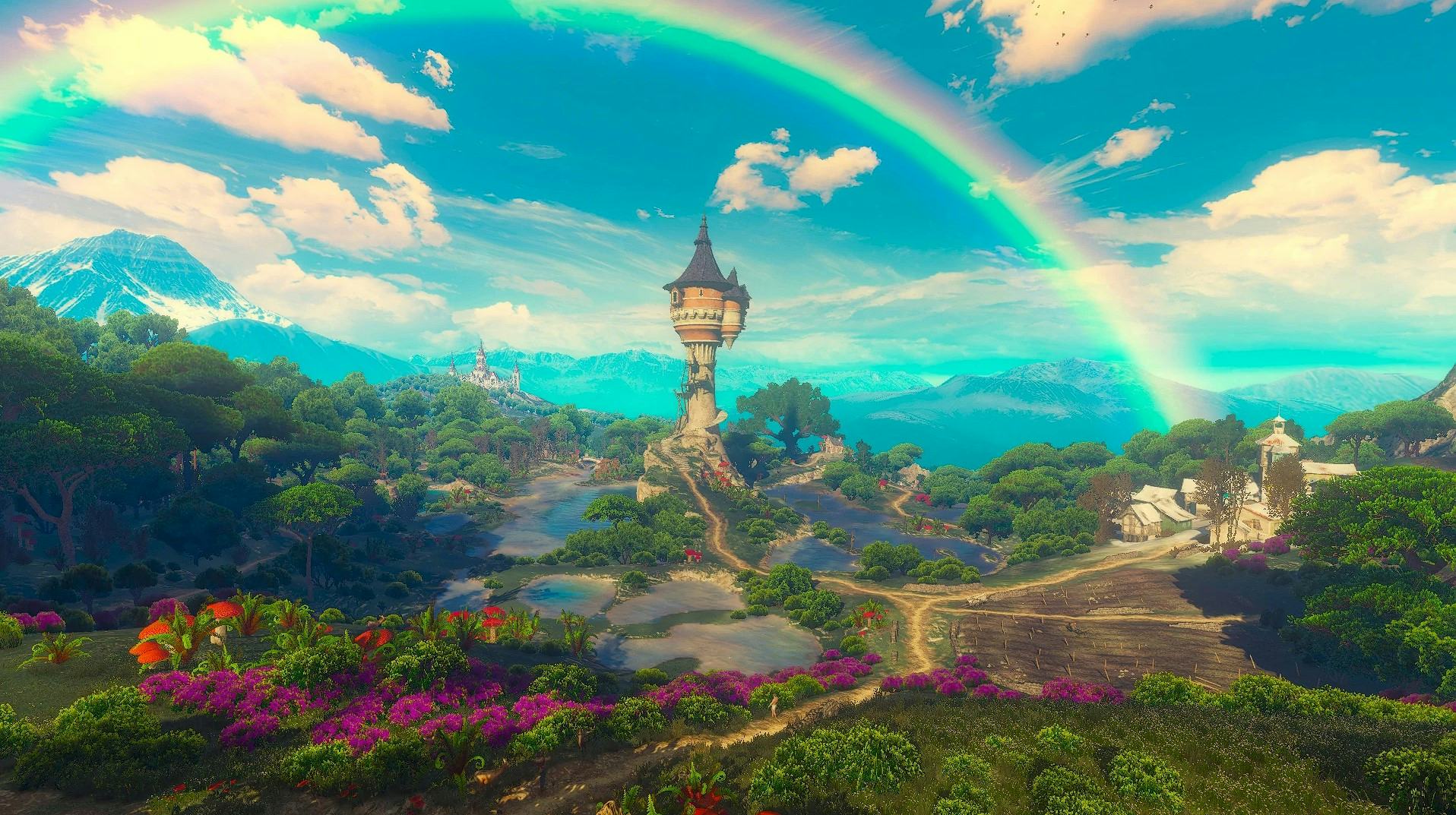
The Witcher 3 is without a doubt one of the greatest RPGs in recent memory — perhaps of all time. The sprawling story following Geralt of Rivia gives players a memorable world to keep coming back to for countless hours. And while the game recently turned seven, we should really be celebrating the sixth anniversary of the best part of The Witcher 3: the Blood and Wine story DLC that concluded Geralt’s adventure.
Life in technicolor
The quest that leads the player into Blood and Wine begins when Geralt stumbles across a notice asking the famed Witcher to accompany two knights to the Duchy of Toussaint. As you ride Roach across the hills and valleys of the land, eventually a cutscene plays that takes you into Toussaint. The first image is a striking vista of vibrant green hills and a piercing blue sky.
Upon first playing this intro, I could not help but think of Dorothy’s entrance to Oz with the drastic shift from black and white to a larger-than-life technicolor stage. This is what it feels like to see Toussaint for the first time.
The Witcher 3 is a beautiful game, but it is a gritty beauty. Dirt and grime cling to the streets and even the clothes on Geralt’s back, mixing with the blood of creatures slain and injuries sustained. Color saturation seems dialed down to emphasize that while this story has dragons and witches, it is not one of your childhood fairytales.
Blood and Wine, however, feels just like a fairytale.
CD Projekt Red took inspiration from real-world locations to craft the in-game world of the Witcher 3. Much of it comes from the developer's home country of Poland. For Toussaint, CD Projekt Red looked to the Mediterranean, modeling the Duchy after Italy, Spain, and the south of France.
After logging dozens of hours in this muted world, being thrust into Toussaint feels like a much-needed breath of fresh air. The quests and combat are unchanged in quality from the base game, which is to say they are still very good. Yet just the visual splendor of the color pallet entices the player to commit to at least 30 more hours of content.
Paint the town red
One of the added benefits of this push toward a colorful world is how it enhances the main questline of Blood and Wine.
Geralt was brought to Toussaint to hunt down the Beast of Toussaint. What originally appears to be a classic monster hunt soon reveals itself to be an intricate plot involving vampires.
These vampires suck blood, claw at enemies, and are put to the sword by Geralt. This is a bloody affair, as is to be expected when vampires are involved. The heightened color palette elevates the gritty action of the base game into a B horror movie send-up. The blood here is bright and shiny, like how one might picture the velvety underside of Count Dracula’s cape.
But this joyous feast for the eyes never gets in the way of the incredible writing that The Witcher 3 quests are known for. The main throughline of Blood and Wine tells a story of grudges and the desire for revenge. It fittingly uses the vampire as a vessel for this story. They are creatures with no regard for time who in their most base form are driven by a singular hunger with no regard for the pain it inflicts. There are of course multiple endings, and it is a joy to experience each one and see what tendrils this story ends in for its characters.
Storybook adventure

Along the way, Blood and Wine veers hard into fairytale when Geralt finds himself having to interact with a collection of classic characters such as Rapunzel and the Big Bad Wolf. All these encounters are tongue and cheek, yet just underneath the surface, there is a sharp edge that makes it truly The Witcher’s take on the fairytale.
In addition, Blood and Wine has some of the most fun and bizarre side quests to enjoy. Separated from the seriousness of the base game Geralt can get into many shenanigans including but not limited to: Recovering a statue’s stolen genitals, fighting a drunk boxer who only fights drunk opponents, doing paperwork, and retrieving Excalibur.
One side quest worth highlighting is “The Warble of a Smitten Knight” which sees Geralt playing wingman for a lovesick knight. The quest is a lengthy chain that takes place entirely around a tournament out of the Renaissance Faire.
Rest and relaxation
At the heart of Blood and Wine’s greatness is its ability to break from the rest of the base game in style and tone. This is the last piece of content for the game, and the last adventure players will have with Geralt of Rivia — for now at least. The team decided to have some fun and leave players with some good memories.
When I return to The Witcher 3, I can’t bear the base game’s color palette. I want to return to ride around on Roach and do side quests for fun, not be steeped in the environmental storytelling of the harsh world. I confess that I mod the game, there are plenty of reshade mods that change the lighting and saturation to make the world a little brighter.
Yet more than longing just for a brighter color palette I find myself longing for a more colorful world. I find myself going back to Blood and Wine. For those who haven’t played the base game, there is an option to play Blood and Wine with a properly leveled new save. Or if you have already played the expansion you can load up your save and Geralt will be waiting for you, lounging on the patio of his winery, not a worry in the world.
The Witcher 3 is available on PS4, Xbox One, Nintendo Switch, and PC, and will come to PS5 and Xbox Series X|S in Q4 2022.







